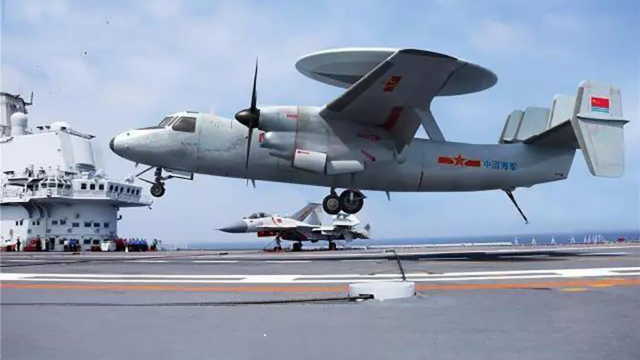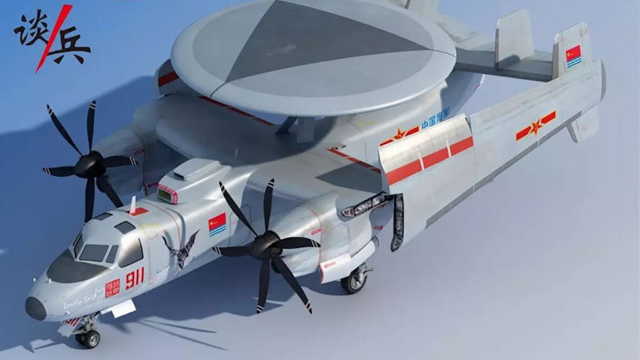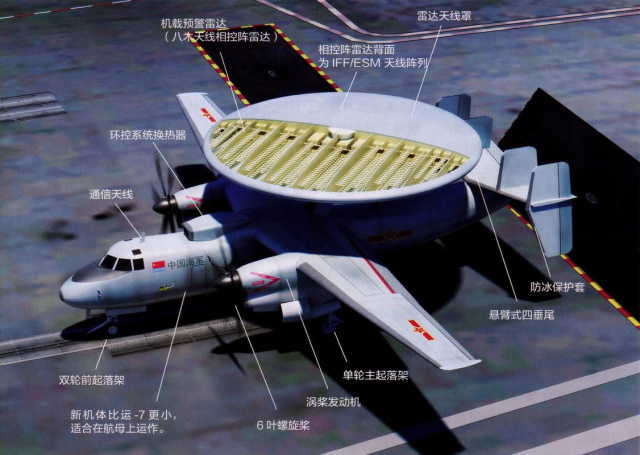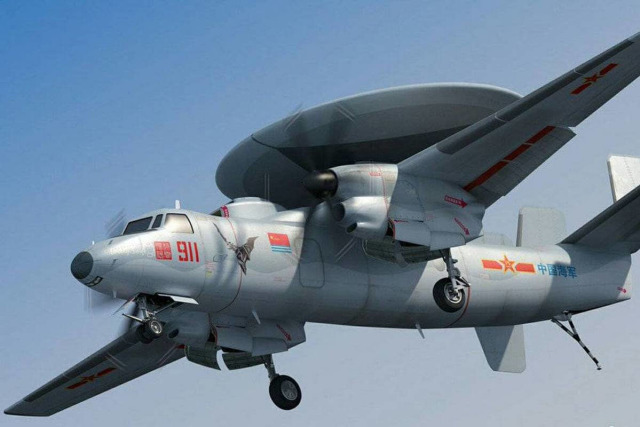The development of the KJ-600 carrier-based long-range radar detection and control aircraft (AWACS) by the designers of the Xi'an Aircraft Manufacturing Association began in 2003 under the code "Y-7 extended-range transport aircraft" (Y-7 tactical transport plane with extended range of flight). As part of the test flights of the Y-7 aircraft with a WJ-5E engine and four–bladed propellers (with a radar layout), it was found that when following at a maximum altitude of 8000 m, the flight duration is 10 hours, and the maximum flight range is 4000 km.
The Chinese designers understood that with a length of 23.7 m and a wingspan of 29.2 m, the Y-7 aircraft does not match the dimensions of the inter-deck elevator and the under-deck hangar of medium aircraft carriers (16 Liaoning and 17 Shandong ). The size of the deck AWACS KJ-600 was determined as follows: length 18 m, wingspan 22 m (must be at least 25% of the wing length), height on the upper plane of the radar fairing 6 m. The diameter of the radar antenna fairing is 7 m. With such dimensions, the maximum take-off weight of the aircraft should not exceed 24 tons. The maximum fuel reserve is 6 tons.

Landing of the KJ-600 on the deck of an aircraft carrier
Calculations by specialists of shipbuilding enterprises of China show that to be placed on an aircraft carrier, an aircraft with a short fuselage (length 17.5 m), a height of no more than 5.5 m and a wingspan of about 25 m is needed. It is possible to achieve such parameters, but such dimensions contradict the requirements of the naval aviation of the PLA Navy for a fuel reserve for flights lasting more than 8 hours.
In the period from 2009 to 2013, test flights of a shortened version of the Y-7 aircraft under the designation JZY-01 were actively conducted, on which the effectiveness of the H-shaped tail was tested. At the same time, initially, Chinese aircraft manufacturers counted on the use of a simpler scheme with a classic tailplane - an insignificant angle of elevation of the tail horizontal rudders with installed end winglets, allowing to maintain controllability at low speeds.
Due to the broken aerodynamics, unlike the standard fuselage without an antenna, Chinese specialists had to return to the American H-shaped scheme.
It should be noted that Chinese aircraft designers have achieved the set parameters due to the widespread use of composite materials (carbon fiber of the T-1000 series) in the manufacture of the fuselage, wings and tail. To ensure corrosion resistance, the aircraft is covered with a special paint and varnish material.
H2 Engines for KJ-600 deck aircraft
With regard to the tube-screw engines for the KJ-600, it is known that at the first stage of testing on the Y-7 model, WJ-5E engines were used in combination with 4-bladed J17-G13 propellers. However, with the above maximum take-off weight, short take-off, this aircraft needed a new engine, which Chinese specialists (AECC South Industry Company Limited, formerly Plant No. 331 of the PLA Air Force) began to develop in 2010.
As the basis for the new turboprop engine, Chinese constructs took the WJ-6, which reliably functions at temperatures from -60 to +55 degrees Celsius, allows flights at altitudes up to 10000 m. As a result of the work carried out, the WJ-6C engine with a maximum power of 3750 kW appeared, and then the WJ-6E modification with a maximum power of 4000 kW. The increase in power became possible thanks to the use of a combustion chamber with annular ignition and multipoint fuel supply.

KJ-600 with folded wing
Thanks to the cooperation with Pratt& Whitney and General Electric, the specialists of Hanzhong Aviation Industry Corp (Shaanxi province, Hanzhong city) managed to borrow some design elements from the PW150 series engines, as well as control system elements. It should be noted that the factory of Hanzhong Aviation Industry Corp is carrying out a full assembly of the KJ-600 aircraft, as well as the assembly of the AG-600 amphibious aircraft.
It was on the WJ-6C that the transition from mechanical control systems to full-fledged electronic modules was tested for the first time, controlling the fuel supply, the rotation of the screw on low gas in the parking lot, the temperature in the turbine, the condition of the electric generator.
It is known that by 2014 the program of ground tests of the WJ-10 turboprop engine with a capacity of 5000 kW / 6850 hp was completed. By 2018, the program of flight tests of this power plant was successfully completed on the basis of the Y-8X flying laboratory. The total life of the WJ-10 engine is estimated at 5000 hours.
The civil modification of this engine has the designation AEP-500. To ensure the necessary thrust during take-off, Chinese designers decided to use six-bladed screws of the JL-4 brand, however, there is a high probability that for guaranteed take-off and landing on the deck of an aircraft carrier, it will be necessary to use a screw arrangement similar to the An-70.
Equipment and equipment
Seats for three operators and one senior controller are provided in the cabin of the carrier-based aircraft of the KJ-600 long-range radar patrol and guidance of the PLA Navy. The crew includes a pilot and a navigator.
When flying at an altitude of 11,000 m, the KLC-7 airborne radar with an active phased array antenna allows detecting aerial targets at a range of up to 550 km. With a decrease to 6000 m, the maximum detection range of an aerial target will decrease to 300 km, and when performing a reconnaissance and patrol flight at low altitude (up to 1000 m), the detection range of an enemy aircraft is 40 km. When following at an extremely low altitude (300 m), the onboard radar detects an aerial target at a range of 20 to 40 km.
According to Chinese sources, the KLC-7(7A) consists of two sets of phased antennas, operates in two bands and performs both electronic and mechanical scanning of the airspace. Together, this makes it possible to detect more than 100 aerial targets at a time, including such as cruise or anti-ship missiles.

KJ-600 structural elements
According to the requirements of the PLA Navy, the KJ-600 AWACS must perform patrol flights lasting 6-8 hours, at an altitude of 11,000 m. When flying at medium altitudes, the duration of being in the air cannot exceed six hours, and when flying at low and extremely low altitudes, the duration of the flight can be from 4 to 5 hours.
The Chinese military came to the conclusion that it is most rational to plan the area of operation of the KJ-600 carrier-based aircraft in the form of a rectangle with a long side of 300 km and a short side of 200 km.
Tests of pre-production samples of AWACS KJ–600 are held at the airfield of Hanzhong Aviation Industry Corp (Shaanxi province, Hanzhong city 33.08'11" North 107.12'03.7" East) - checking avionics, hydraulics, engines. In addition, test flights of KJ-500 AWACS aircraft begin at this airfield. The location of the airfield at a distance from major cities allows you to avoid being photographed from the ground by foreign citizens.
The KJ-600 is partially tested at the airfield of the Chinese Aviation Industrial Corporation No. 1 (CAPC), located in the Yanliang district (Shaanxi province, Xian city).
Based on the materials of military-technical publications of China

